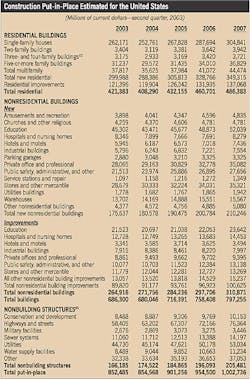The residential construction boom hit its peak in 2002 but began to slip in the first quarter of 2003 due to weather conditions and consumer and builder sentiment. The market, however, may increase in volume through the next few months before leveling out in the fall, according to FMI's Construction Outlook: Second Quarter 2003 Report. The second quarter 2003 outlook for construction put-in-place was revised upward due to a possible improvement in the residential construction market. Low mortgage rates, moderate home prices, and strong personal incomes are helping the construction market continue at its 2002 pace, but interest rates and tightening lending regulations could cause a slowdown in 2004. The commercial sector, however, could rebound because of less high-profile bankruptcies, mass layoffs, and a higher availability of bank credit. The February 2003 value of nonresidential building construction was $159.8 billion, which was 0.3% above the revised January estimate of $158.3 billion. The commercial construction market may show signs of improvement after hitting rock bottom, but FMI forecasts that low volumes could continue for another year. Construction of amusement and recreation facilities may experience a slowdown in 2003 because of a drop in leisure travel, reduced availability of public and private funds, and a weak economy. FMI also predicts that the construction of university stadiums and public art galleries will fail to rise up to 2002 levels. The weakness in the commercial sector may soon spread to the public sector, where contractors may face a budget crunch at both the state and federal level.
